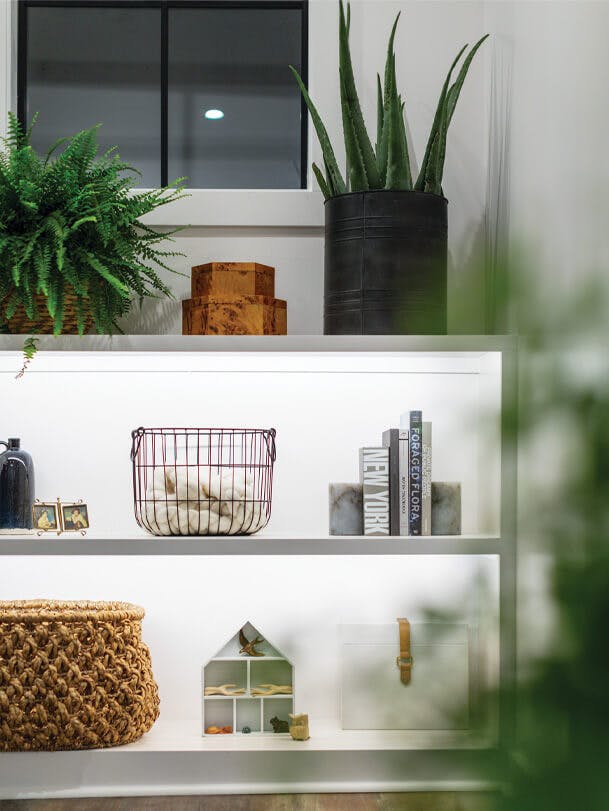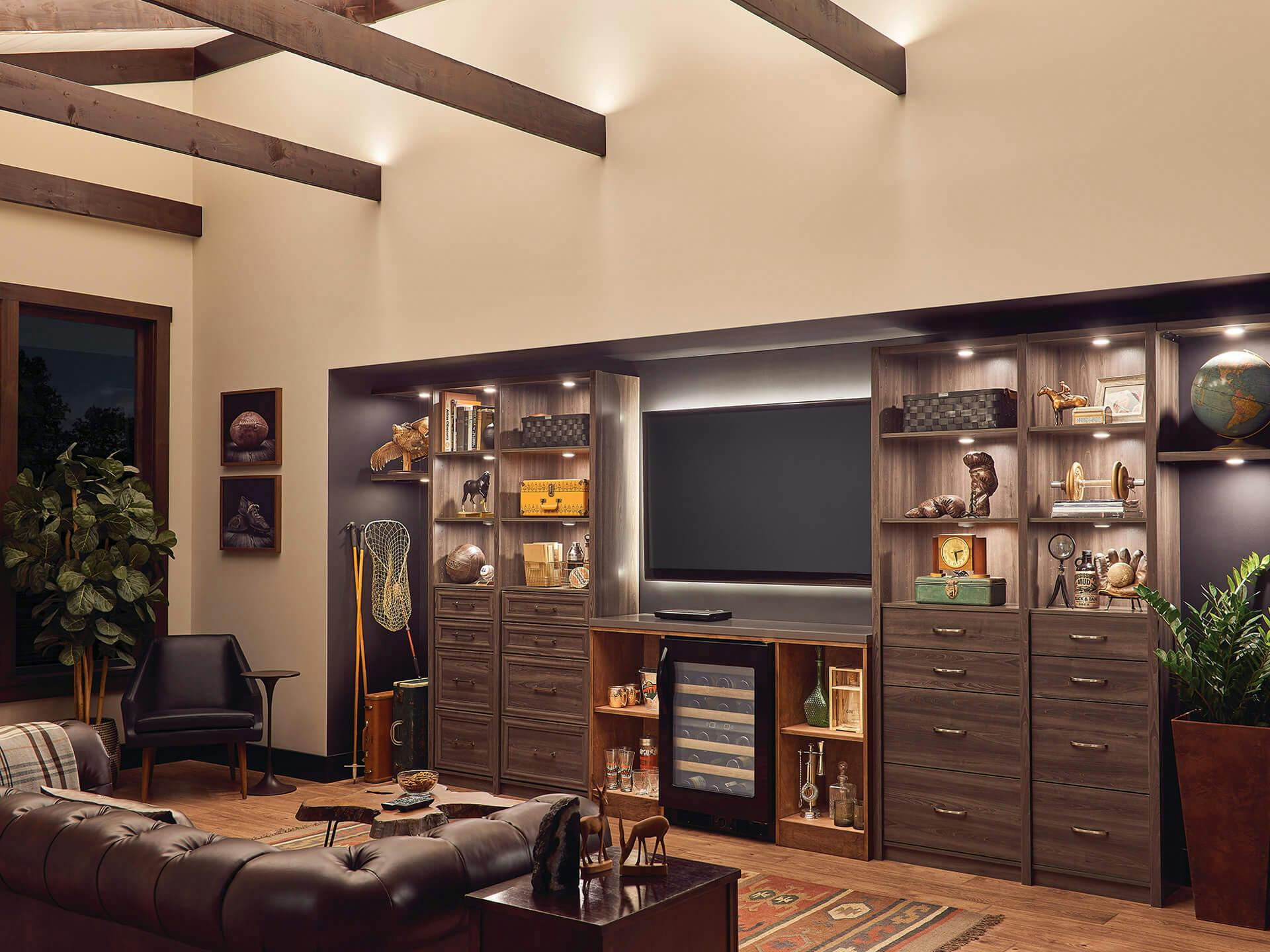
Indoor Lighting Guide
Here we shed light on some tips and tricks that will help with selection, final installation and everything in between.
Project Planning for Cabinet Lighting

Maybe you’ve already committed to a new cabinet lighting project. Or maybe you’re intrigued to learn more before getting started. Either way, the first and most important step is project planning. Project planning helps you determine what lighting effects you want for your space before construction or remodeling begins. Not only does this help you cover all of the intricate details from light source (modular LED fixture vs LED Tape Light) and electrical connections, but it avoids extra costs, rework or contractor callbacks.
Follow these simple steps to create your cabinet lighting plan.

Step 1: Identify Your Needs and Objectives
Make sure you have a clear idea of what you want to accomplish to set your project up for success. These are a few considerations before you get started.
Consider your needs. First, think about the functional and aesthetic needs of your space. Is it a high-utility area, like a kitchen countertop or workspace? Do you want to highlight a special design element, add warmth, or make the space look bigger? Some cabinet lighting solutions blend task and accent lighting. For example, under cabinet lighting illuminates your kitchen workspace and your beautiful backsplash at the same time. Other options serve a single purpose, like over cabinet lighting that draws the eye to a sophisticated architectural detail.
Think about the bigger picture. Sure it’s important to think about the individual space first, but you also need to consider how your lighting plan works within the overall context of your space. For instance, a room with lots of natural or ambient light may require a different solution than a windowless space. You also can’t forget about day-to-night needs. A room with a skylight and windows may shine bright throughout the day, but needs accent lighting at night. You also need to consider color temperature. Do you want a warm cozy feel or cool energizing light in your space? One way or the other, make sure the color temperature fits with the function of the space, along with other colors and design finishes.
Find inspiration all around you. You may not realize the perfect solution exists until you discover it. Dig into magazines and catalogs, flip on home improvement shows, and research plenty of blogs - like this article (well done!). The resources are endless. Our quick introduction to cabinet lighting offers plenty of inspiration.
Consider installation. Once you have your vision, you need to think about if you want to DIY or hire a professional. Depending on your skills, budget, comfort level and objectives, this decision impacts your options. If you’re already hiring help for a room remodel or new construction, you can make cabinet lighting part of that plan. Our guide to installing your cabinet lighting can help you prepare for the tasks ahead.
Step 2: Choose the Right Cabinet Lighting for Your Needs
There are options from floor to ceiling and everything in between. Remember, don’t feel too overwhelmed if you can’t decide which option is right for you. Your plan will likely include many solutions.
Under Cabinet Lighting. Extend usable workspace by illuminating high-function areas like countertops, sinks and stoves. After dark, under cabinet lighting can act as kitchen night lights while creating a relaxing ambiance.
Over Cabinet Lighting. Lighting the open space between the top of cabinets and the ceiling adds intrigue and interest, especially if you’re displaying décor or plants. It also visually expands the room, giving the appearance of a much larger space.
Under Counter Lighting. Effectively illuminate the interior of cabinet drawers with concealed under-counter lighting. It also sets off the architectural edge of the counter. If this is an option you want to consider, it may be wise to discuss concealment options with an electrical contractor or countertop pro.
Inside Cabinet Lighting. This option offers the best of both worlds by combining aesthetic and functional benefits. Use it to highlight decorative dinnerware, art or antiques, or make it easier to access supplies in deep cabinets or storage areas.
Toekick Lighting. Properly positioned near the floor, toekick lighting gives the visual illusion of floating cabinetry, defines baseline edges and adds depth to floor coverings. It also increases safety, especially at night, by illuminating footpaths and preventing accidental trips or stubbed toes.
Near Cabinet Lighting
Under Table/Island Lighting. Visually expand and bring your space to life by adding light under tables and islands.
Coves and Tray Ceiling Lighting. Both cove and tray ceiling styles are architectural details worthy of attention. With a cove ceiling, a soft light draws the eye up, creating the illusion of added height. Tray ceilings benefit from a layered effect that adds visual interest.
Step 3: Choose Your Fixtures
Once you’ve picked the right cabinet lighting effects for your space, you need to choose the actual light fixtures to do the job. If you’re looking for recommendations, we have plenty.
Under Cabinets
LED under cabinet fixtures Highly efficient, long-lasting LEDs offer low operating costs and minimal heat. These fixtures feature the many components of a system in one - making them easy to install, and offer tremendous light output and quality to match.
LED tape lighting is an ultra-thin LED light source that adds design flexibility. The sleek profile of tape light allows for mounting in almost any and can be trimmed to varying lengths or installed as one longer run. The drawback: they deliver a lower lumen output than LED fixtures, meaning slightly less illumination.
Over Cabinets
LED tape lighting provides ambient light output to help illuminate the space above cabinets without a spotlight effect. LED tape lighting is also dimmable, so you can match the intensity of the light to the occasion.
LED Hard strip lighting generally delivers more light and is easier to keep clean. The only negative is that these lights can’t be customized by length like LED tape.
Inside Cabinets or Drawers
LED tape lighting - The low profile of this LED tape light is a perfect fit for the small space inside a cabinet or drawer.
LED strip lights - The durability of hard strips makes these lights a smart choice for high-use cabinets.
Accent disc (or puck light) - although not ideal for drawers, LED accent discs provide ample lighting to glass faced cabinets as well as open shelving. They can be mounted to the surface or recessed for a desired look.
Below Counters/Toekick Areas
LED tape lighting - Its low profile and easy adhesion make LED tape the ideal solution for the often hard-to-reach or small-space installations like below counters or toe kicks. Consider utilizing shallow depth channels with a lens for added protection for the tape.
Step 4: Set-Up Installation
If you’ve enlisted help, your work is almost done. If you’re thinking about installing yourself, our installation prep article is worth a read.